Bees, those industrious pollinators, lead lives far more complex than we often appreciate. Beyond honey production and pollination, they possess a sophisticated communication system, a form of Interpretative Dance, that allows them to share vital information about their environment. This dance, known as the waggle dance, is not just a charming display; it’s a crucial tool for understanding how bees navigate their world, find resources, and respond to environmental changes.
In the depths of winter, when the world outside seems dormant, even bee colonies exhibit subtle signs of life. A colony check in late December revealed intriguing variations in hive conditions. While some hives showed clean mesh floors beneath, indicating minimal bee mortality, others presented a scattering of corpses. This observation raises questions about bee health and colony dynamics during the colder months.
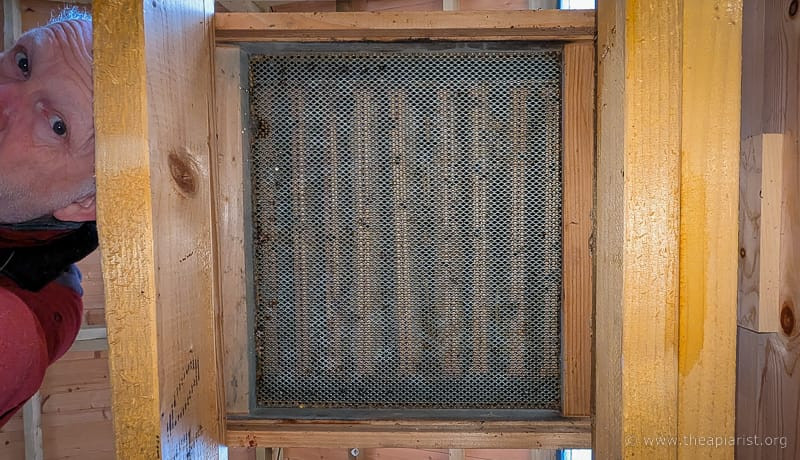 Late December bee corpses on an open mesh floor, indicating natural attrition within the bee shed.
Late December bee corpses on an open mesh floor, indicating natural attrition within the bee shed.
Why do some hives accumulate more deceased bees than others during winter? Several factors could contribute. Natural attrition of winter bees, the long-lived generation that sustains the colony through cold months, is a primary cause. Colony size variations could also play a role; larger colonies might naturally experience a higher number of deaths simply due to population size. The timing of winter bee production within a colony could also be a factor, with earlier generations potentially experiencing higher mortality rates over time. It’s crucial to note that in this specific apiary, Varroa mites, a major bee pest, are minimal, ruling out Varroa-related disease as a significant cause for these variations in bee mortality. Furthermore, the absence of bee flight activity due to low temperatures eliminates the possibility of corpse removal by undertaker bees.
But let’s shift our focus from winter mortality to the vibrant life of bees during foraging season. The intricate world of bee foraging and communication offers a far more engaging narrative. To escape the winter contemplation of bee corpses and unbuilt frames, delving into the science of bee foraging distances and their seasonal variations provides a welcome mental escape. It evokes images of summer days, fields brimming with wildflowers, clover, and oilseed rape – a stark contrast to the winter stillness.
Recent headlines highlighting pollinator decline and severe weather events underscore the critical importance of understanding bee foraging behavior. Deciphering how bees adapt their foraging strategies in response to environmental changes, resource availability, and even pollinator competition becomes increasingly vital. The interpretative dance of bees holds the key to unlocking these insights.
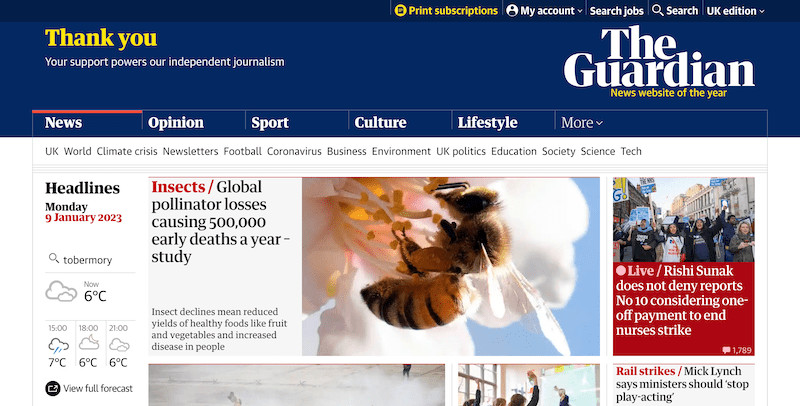 Front page of The Guardian highlighting pollinator losses and severe weather events, emphasizing the environmental context of bee foraging.
Front page of The Guardian highlighting pollinator losses and severe weather events, emphasizing the environmental context of bee foraging.
Even beyond the pressing concerns of ecological collapse and climate change, the mechanics of bee foraging are inherently fascinating. Imagine witnessing bees emerge from their hive on a warm summer day, embarking on journeys to distant floral resources. How far do they travel? How do they decide where to go? The answer lies in their remarkable communication system.
The Waggle Dance: A Masterclass in Non-Verbal Communication
While humans use language, and even trained animals respond to commands, true two-way communication across species is rare. Bees, however, offer a unique window into animal communication. Through their interpretative dance, we can effectively “eavesdrop” on their conversations. Returning forager bees communicate with their hive mates, conveying precise information about the location, distance, and even quality of food sources. This intricate communication is primarily achieved through the waggle dance.
Karl von Frisch’s Nobel Prize-winning research in 1973 illuminated the complexities of the waggle dance. It stands as arguably the most sophisticated communication method known in insects, and perhaps in the entire animal kingdom outside of humans. The dance consists of two main phases: the waggle run and the return phase. During the waggle run, the bee moves in a straight line while vibrating its abdomen from side to side. The return phase involves a looping movement back to the starting point for another waggle run.
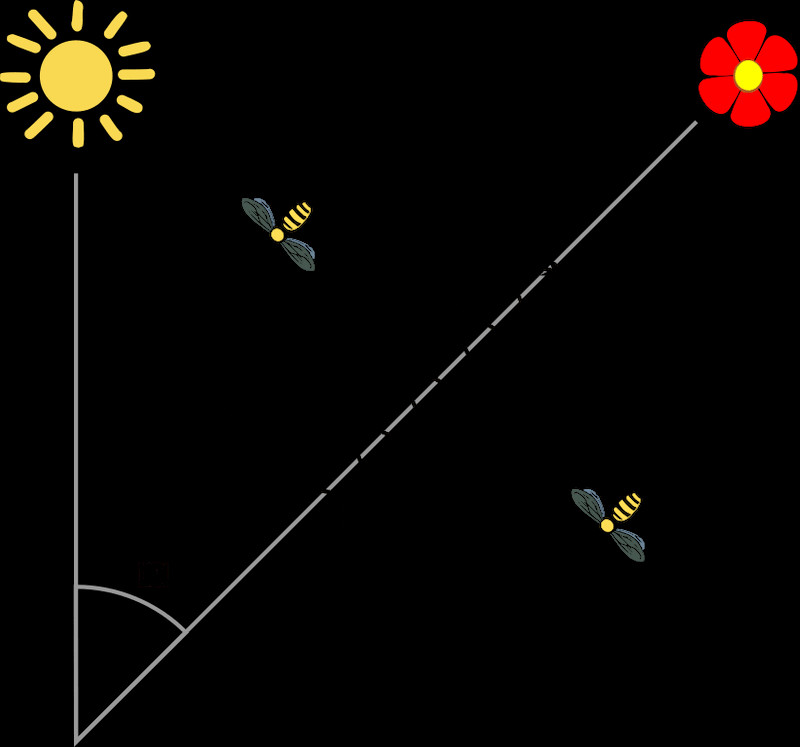 Diagram illustrating the waggle dance, showing the waggle run and return phase.
Diagram illustrating the waggle dance, showing the waggle run and return phase.
The waggle run is the information-rich component of the dance. The duration of the waggle run directly correlates with the distance to the food source. The angle of the waggle run, relative to the sun’s position (solar azimuth), indicates the direction. By observing and recording waggle dances within a glass-sided observation hive, scientists can decipher the likely locations of nectar, pollen, water, or resin sources that bees are exploiting.
Overcoming the Noise: Decoding the Dance with Precision
While the principles of waggle dance interpretation seem straightforward, the reality is more complex. Waggle dances are inherently “noisy.” Bees returning from even a single, concentrated food source, like a scientist-placed syrup feeder, exhibit variations in their dances. This variability occurs both in sequential dances by the same bee and among different bees reporting the same location. This “noise” translates to variations in both distance and direction components of the dance, making accurate interpretation challenging, especially when tracking foraging changes over time.
However, from a bee’s perspective, this “noise” is likely not a problem. In natural environments, nectar sources are rarely isolated points. Instead, bees often forage in areas rich in flowers, like entire fields. As long as dance-following bees are directed to the general area, they are likely to find ample resources. The precision required for pinpointing an exact flower is simply not necessary.
To address the “noise” in waggle dance interpretation, scientists have developed sophisticated methods. Couvillon and colleagues (2012) demonstrated that analyzing multiple waggle runs within a single dance, specifically runs in the middle of the dance sequence, improves accuracy. Ignoring the first and last runs and focusing on four consecutive runs provides a more reliable prediction of the food source location.
Furthermore, rather than pinpointing a single location, it’s more accurate to predict a probability distribution. Roger Schürch (2013) employed advanced statistical analysis on both his own data and archival data from pioneers like von Frisch and Wenner. His work confirmed a linear relationship between waggle run duration and distance, and that directional variation is independent of distance. Crucially, by combining data from multiple dances and simulating thousands more with realistic variations, Schürch developed a method to generate probability maps of likely foraging locations.
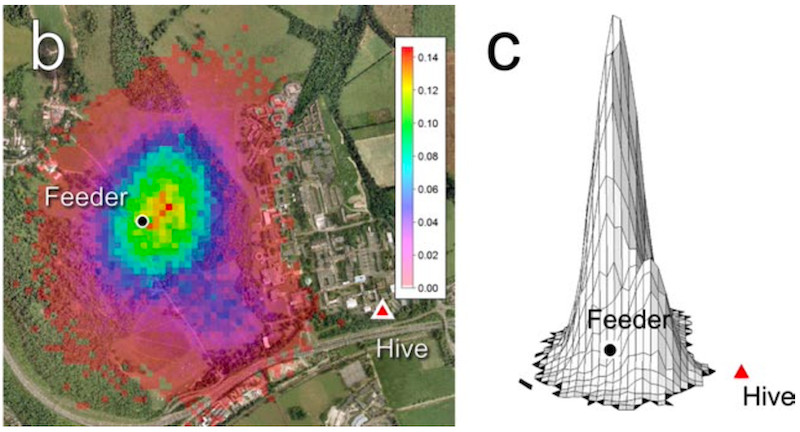 Heat map and 3D representation of waggle dance probability distribution, showing likely foraging locations.
Heat map and 3D representation of waggle dance probability distribution, showing likely foraging locations.
These probability maps visually represent the likelihood of a food source being in a particular area. “Hotter” colors like red indicate higher probability, while “cooler” colors like blue represent lower probability. The 3D projection further emphasizes the probability distribution, effectively pinpointing the most probable foraging areas.
Seasonal Foraging: A Dance of Adaptation
Building on these methodological advancements, Couvillon, Schürch, and Ratnieks (2014) conducted a comprehensive two-season study to investigate seasonal foraging patterns. By recording over 5000 waggle dances, they aimed to answer key questions about how foraging areas change throughout the year, the influence of temperature on foraging distances, and the role of nectar quality in foraging decisions.
Their study, conducted at the University of Sussex, located in a landscape blending farmland and urban development, provided valuable insights into bee foraging behavior in a complex environment. Approximately 21% of the 4 km radius study area around the hives was urban or suburban, offering a mix of foraging opportunities.
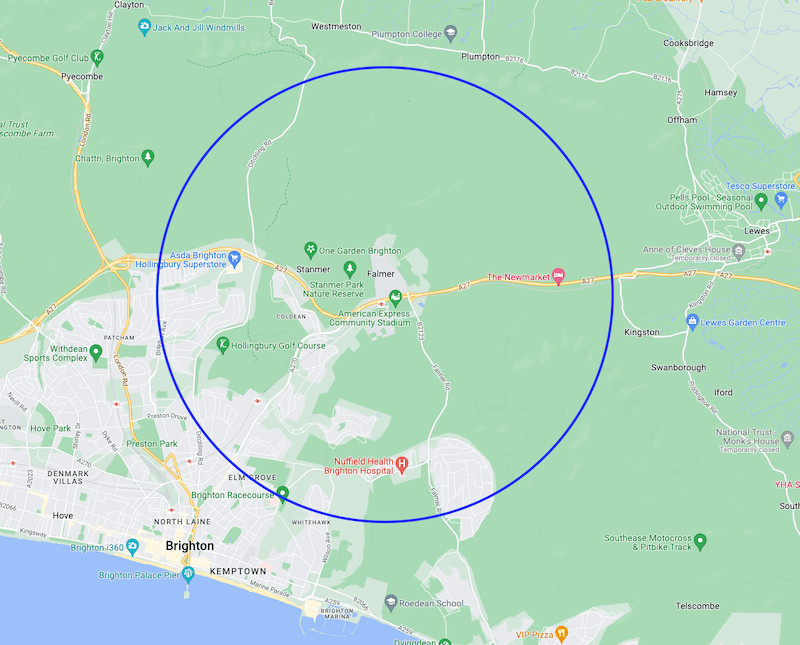 A 4 km radius circle study area map, highlighting the mix of urban and rural landscapes surrounding the hive location.
A 4 km radius circle study area map, highlighting the mix of urban and rural landscapes surrounding the hive location.
The analysis of over 5000 dances recorded between August 2009 and July 2011 (excluding non-foraging winter months) revealed striking seasonal variations in foraging distances. Bees consistently foraged significantly further in the summer months compared to spring and autumn.
Average foraging distances were approximately 493 meters in early spring (March), soared to 2156 meters in summer (July/August), and decreased to 1275 meters in autumn (September/October). These figures clearly demonstrate a dramatic expansion of foraging range during the summer.
Interestingly, no correlation was found between ambient temperature and foraging distance. Despite warmer summer temperatures, the increased foraging distances were not simply a result of bees being able to fly further in warmer conditions. Instead, the bees were actively choosing to fly further, suggesting a necessity rather than a preference driven by temperature.
To investigate the role of nectar quality, the researchers measured the sugar content of nectar carried by returning foragers. Despite month-to-month variations in nectar sugar concentration, no correlation was found between nectar quality and foraging distance. This crucial finding indicated that bees were not foraging further in summer to exploit richer nectar sources. Instead, they were traveling greater distances because closer, high-quality nectar sources were likely less available.
The Expanding Sphere of Influence and Implications for Pollinators
The concept of a hive’s “sphere of influence,” defined by the maximum flight ranges of bees, becomes particularly relevant when considering these seasonal foraging changes. During summer, the sphere of influence expands dramatically as bees travel further to find resources.
Seasonal heat maps generated from the waggle dance data visually represent these changes in foraging areas. These maps clearly illustrate the significant difference in foraged areas between spring, summer, and autumn. The area visited by foragers expanded from 0.8 km² in spring to 15.2 km² in summer, before contracting to 5.1 km² in autumn. These differences are not driven by nectar quality or temperature preferences, but rather by the changing availability of resources closer to the hive.
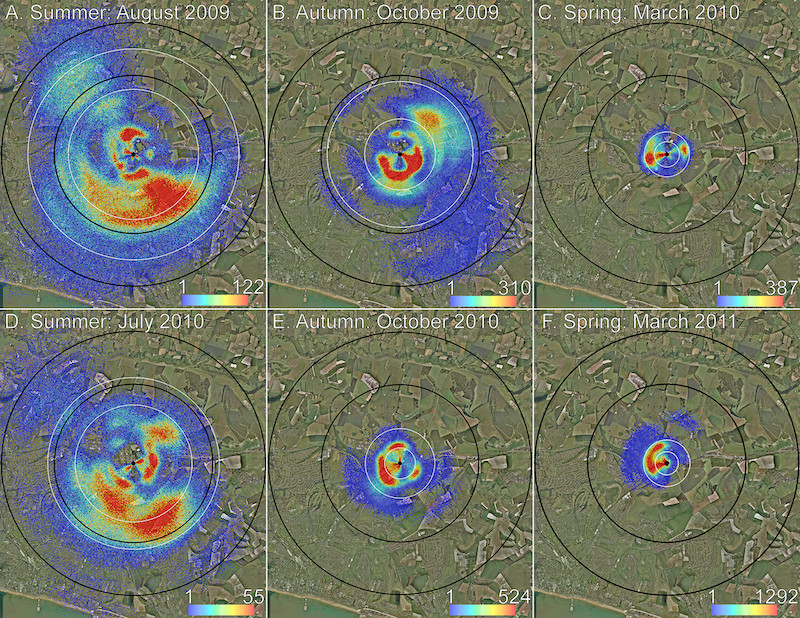 Heat maps showing seasonal differences in foraging areas, illustrating the expansion in summer.
Heat maps showing seasonal differences in foraging areas, illustrating the expansion in summer.
The study highlights that even though honey bees are generalist foragers, capable of utilizing a wide range of floral sources, they experience periods of resource scarcity. The increased foraging distances in summer suggest a “lean” period when readily accessible, high-quality nectar sources become less abundant near the hive.
This has significant implications for other pollinators. Honey bees, while not necessarily the most efficient pollinators individually, compensate with sheer numbers. If honey bees are struggling to find sufficient resources and expanding their foraging ranges, it’s highly likely that other pollinators, many with smaller foraging ranges, are also facing increased competition for dwindling resources within their local environments.
The interpretative dance of honey bees, therefore, provides a powerful tool for assessing the overall availability and quality of nectar and pollen in an environment. By monitoring waggle dance distances and foraging areas, we can gain valuable insights into the challenges faced not only by honey bees but also by the broader pollinator community.
In a changing world, understanding these dynamics is crucial. Climate change is altering flowering times, and extreme weather events like droughts can negatively impact plant productivity and seed set. Honey bees, through their interpretative dance, serve as sensitive indicators of these environmental changes. By listening to and understanding their communication, we can gain a deeper appreciation for the interconnectedness of ecosystems and the challenges facing pollinators in an increasingly uncertain future.
This type of research, leveraging the power of interpretative dance in bees, is not just academically interesting; it has real-world implications for conservation, land management, and ensuring the health of both bee populations and the ecosystems they support. Perhaps beekeepers and policymakers alike should pay closer attention to the messages bees are conveying through their remarkable dances.
References
Couvillon, M.J., Riddell Pearce, F.C., Harris-Jones, E.L., Kuepfer, A.M., Mackenzie-Smith, S.J., Rozario, L.A., et al. (2012) Intra-dance variation among waggle runs and the design of efficient protocols for honey bee dance decoding. Biology Open 1: 467–472 https://doi.org/10.1242/bio.20121099. Accessed January 10, 2023.
Couvillon, M.J., Schürch, R., and Ratnieks, F.L.W. (2014) Waggle Dance Distances as Integrative Indicators of Seasonal Foraging Challenges. PLOS ONE 9: e93495 https://journals.plos.org/plosone/article?id=10.1371/journal.pone.0093495. Accessed January 7, 2023.
Osborne, J. l., Clark, S. j., Morris, R. j., Williams, I. h., Riley, J. r., Smith, A. d., et al. (1999) A landscape-scale study of bumble bee foraging range and constancy, using harmonic radar. Journal of Applied Ecology 36: 519–533 https://onlinelibrary.wiley.com/doi/abs/10.1046/j.1365-2664.1999.00428.x. Accessed January 10, 2023.
Schürch, R., Couvillon, M.J., Burns, D.D.R., Tasman, K., Waxman, D., and Ratnieks, F.L.W. (2013) Incorporating variability in honey bee waggle dance decoding improves the mapping of communicated resource locations. J Comp Physiol A 199: 1143–1152 https://doi.org/10.1007/s00359-013-0860-4. Accessed January 9, 2023.
